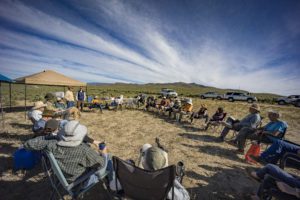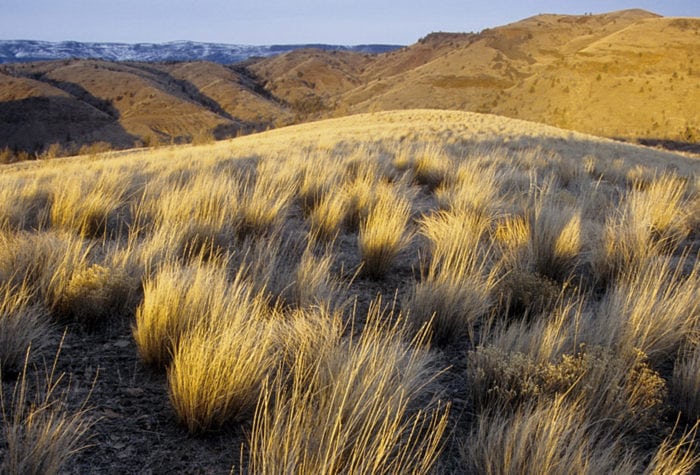Author: Anne White | Published: February 16, 2023 | Category: Look Back
In June 2022, ONDA hosted a site visit to McDermitt Creek in southeastern Oregon to introduce desert advocates to a landscape threatened by a proposed mine.
Standing at the edge of the McDermitt caldera, rolling sagebrush hills stretch out before me in every direction, as McDermitt Creek flows to the south. Earlier this morning, I’d been bundled up, with my jacket hood zipped up to my chin leaving only the smallest portion of my face exposed; by one o’clock in the afternoon, perspiration was beaded on my brow and bare arms. Sagebrush lizards, perceptible only by their trailing shadow, darted from shrub to shrub amongst the coral blossoms of globemallow, fragrant tufted evening primrose and the blue petals of delphinium. The melodic trill of sagebrush sparrows and the buzzy song of Brewer’s sparrows floated in the breeze, punctuated by the purring chorus of sandhill cranes in distant meadows.
Twenty volunteers from across Oregon and Idaho had trekked out to this place – the remnants of a collapsed volcano in the Trout Creek and Oregon Canyon Mountains foothills – because eons of erosion have concentrated minerals in the soil here, including one so valuable it is attracting international attention: lithium.
 We had come to listen, learn and document. From Daranda Hinkey and Myron Smart, both members of the Fort McDermitt Paiute and Shoshone Tribe and the People of Red Mountain, we were honored to hear a greeting and prayer in the traditional language that conveyed the reciprocal relationship with the landscape. Oregon Department of Fish and Wildlife staff described how losing this habitat to an open-pit mine would have devastating impacts on an already imperiled greater sage-grouse population and undermine decades of work the State of Oregon and partners have undertaken to restore the federally threatened Lahontan cutthroat trout in McDermitt Creek. From the local rancher whose family has held grazing permits in the area for five generations, we learned that the loss of rangeland would be devastating to their livelihood and the end of their ranching operation.
We had come to listen, learn and document. From Daranda Hinkey and Myron Smart, both members of the Fort McDermitt Paiute and Shoshone Tribe and the People of Red Mountain, we were honored to hear a greeting and prayer in the traditional language that conveyed the reciprocal relationship with the landscape. Oregon Department of Fish and Wildlife staff described how losing this habitat to an open-pit mine would have devastating impacts on an already imperiled greater sage-grouse population and undermine decades of work the State of Oregon and partners have undertaken to restore the federally threatened Lahontan cutthroat trout in McDermitt Creek. From the local rancher whose family has held grazing permits in the area for five generations, we learned that the loss of rangeland would be devastating to their livelihood and the end of their ranching operation.
The impacts of climate change are already palpable here. Temperatures in southeastern Oregon have increased by nearly 2 degrees Celsius since 1985. Winters are milder and summers are hotter, with variable and declining precipitation each year. It’s clear our carbon emissions need to be drastically reduced and replaced by renewable energy. Lithium-ion batteries are being touted as the solution with companies looking to McDermitt as a domestic source for this critical mineral. But, is this the right place to dig a miles-wide pit?
Observing the bounty of plant and animal life here, it’s clear this area is an ecological refuge. The Bureau of Land Management has designated the entire region as a Climate Change Consideration Area — relatively undisturbed, high elevation areas that are most likely to persist under climate change and offer the best habitat for sage-grouse survival. This area became even more vital after the Holloway Fire in 2012 burned more than 460,000 acres of public lands to the south, west and north of the caldera. It is now the only remaining expanse of intact sagebrush steppe in an area vitally important to greater sage-grouse, Lahontan cutthroat trout, mule deer, pronghorn, and numerous other sagebrush-dependent species. At McDermitt Creek, all the players — from the fungi in the soil to the trout in the streams and the pronghorn racing across the sagebrush — fill their niche in the ecosystem without interruption. And, for a brief time, we were part of this landscape, too, experiencing a place where the natural world is in balance.
ONDA’s effort to preserve the vital habitat in this remote landscape is just beginning, and this matter may not be resolved for more than a decade, but, on that weekend, I saw how success could be achieved. By the end of our third day of work, our crew of volunteers was sunburned, covered in a fine layer of sweat and dust and bleary-eyed from the unrelenting sun. And yet, they were buzzing with a newfound devotion to this place. As we share the values of this landscape with more people, they too will feel that connection and be inspired to defend it.
